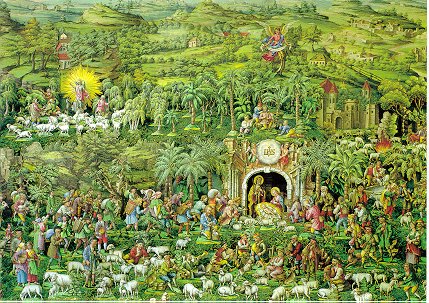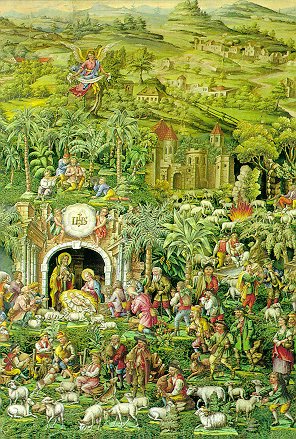Ustí nad Orlicí Painted Creches
Ústí nad Orlicí Painted Creches
Q: What can you tell me about the painted crèches and the painted crèches of Ústí nad Orlicí in the Czech Republic?
A: Painted crèches are found from the eighteenth century onward. Painters, guilders, and artists were also simple weavers, smiths, bakers, and shoemakers. They could also be velvet weavers and teachers and so forth. The painting of the cribs of Ústí nad Orlicí reached their highest peak of perfection towards the end of the nineteenth century. These still exist today.
beltemy2.JPG (79261 bytes)The cribs shown here are 3-10 meters in length and minimally 1 meter in depth. The basic wooden scaffold has a base of 1.20-1.40 meters. It consists of several separate layers or actual stages and are regularly arranged up to the ceiling of the room. The heart of the setting and main focal point is the crèche itself--usually a little stable, a cave or a church half in ruins. The Holy Family is placed into the setting on Christmas Eve. Above the village, attention is drawn to it by illustrating "Zvestovani" (Annunciation). This is illustrated by a small group of surprised shepherds and many frightened sheep. To the right of the cribs, one sees the town with its precious church spires and the arrangement of fortifications.
A unique characteristic of Ústí nad Orlicí crèches is what is called "dalina" or "lancroft," which means that a 30 cm large paper band (one or more) is painted as a landscape without a sky. The horizon of the painting is cut in the shape of the landscape. The landscape image on the "lancoft" crib is displayed without sky so that the brilliancy of its colors and the contours of its horizon will be represented.
beltemy3.JPG (79261 bytes)The remaining area of the crèche is overflowing with troops of "darovnik" (donors that have large and small numbers of sheep. Some crib builders call these the "snow of cribs of Usti." In back of the crèches, there is a small piece of wood, which is about 5-7 cm, which help to support the crib. At present, there is also a very rare kind of moss that also designates these crèches.
Apart from Christmas crèches built by the people of Ústí nad Orlicí, there are also three other types of construction for crèches. They are the Epiphany type (January 6), Candlemas type (February 2), and the Carnival type (Easter type). On the fifth of January, the front "darovnik" crèches are replaced by the kings Casper, Melchior together with their processions on one side and on the other side is Balthasar accompanied by camels and elephants. The angels suspended at the top of the crib are replaced by a comet.
Candlemas versions of the cribs are denoted by some crib builders as "Ocistovani Pane" (sacrifice to the Christ) and by others for its "Ocistovani Panny Marie" (Mary’s purification). Instead of a crèche, this scene is characterized by a church erected where Simon is supporting baby Jesus. St. Joseph stands to one side with two pigeons resting in his hands. Mary and St. Anne are stand by as witnesses.
Lenten versions of the crèches replaced entertainment during the period of strict fast and abstinence and depicted Christ being arrested, preceded by scenes of Christ on the Mountain of Olives where he accepts from the angel the chalice of torment. In addition to the three apostles, there were also candle carriers, Roman mercenaries, "zakonik" law scholars, people of the nation and the high priests who accepted from Judas thirty silver pieces for Jesus Christ. The Gethsemane Garden is displayed in the enclosure.
Visitors to the towns of Ústí nad Orlicí will find the Christmas crèches in the town museum, where there are examples of thirty-two known painters presented. Crèches are still being created in many households in the area because their creation is considered a most precious keepsake of the family. The "visiting" of the Christmas cribs during Christmas or January and February represents a love of tradition and everyone is always welcome.
All About Mary includes a variety of content, much of which reflects the expertise, interpretations and opinions of the individual authors and not necessarily of the Marian Library or the University of Dayton. Please share feedback or suggestions with marianlibrary@udayton.edu.


